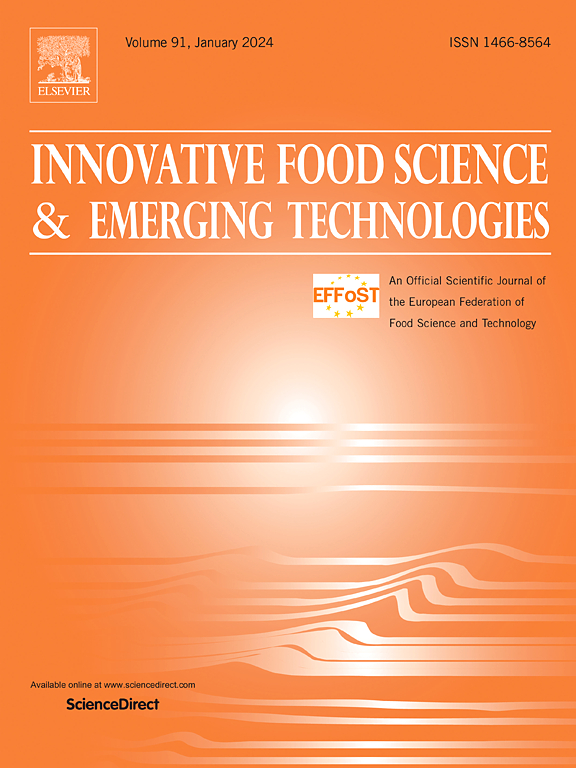Enhancing hydrothermal extraction of plant cell wall polysaccharides using radio frequency energy: A case study on extracting pectin from pomelo peels
IF 6.8
1区 农林科学
Q1 FOOD SCIENCE & TECHNOLOGY
Innovative Food Science & Emerging Technologies
Pub Date : 2025-07-16
DOI:10.1016/j.ifset.2025.104119
引用次数: 0
Abstract
Radio frequency (RF) heating and hydrothermal treatment, as environmentally friendly and efficient technologies, have been widely applied in food processing. This study aims to investigate the effect of RF-assisted hydrothermal extraction (RFAHE) of plant cell wall polysaccharides, using pomelo peel pectin (PPP) as a case study. Based on the optimized RFAHE operating conditions, the yield, physicochemical, and structural properties of PPP obtained from RFAHE, acidic RFAHE (ARFAHE), microwave-assisted HE (MWAHE), and hydrothermal extraction (HE) alone were compared. The optimized RFAHE conditions are as follows: heated at 122 °C and liquid/solid ratio of 40 mL/g for 17 min. The pectin yields were 20.8 ± 0.7, 20.6 ± 0.8, 23.8 ± 0.6, and 18.7 ± 0.6 % for RFAHE, MWAHE, ARFAHE, and HE alone, respectively. Among the four samples, the RFAHE sample had the highest degree of esterification and antioxidant capacity, as well as the lowest molecular weight, while the ARFAHE sample exhibited the opposite characteristics. The GalA content of the RFAHE sample was higher than that of the MWAHE sample but slightly lower than the standard for commercial food-grade pectin. FTIR, XRD, and 1H NMR analysis indicated that there were no significant differences in the main chemical structures among the four samples. The results from this study confirm that the extraction efficacy of RFAHE is superior to that of MWAHE, and offer fundamental insights into the application of RFAHE for recovering cell wall polysaccharides from plant food wastes and byproducts.
利用射频能量强化水热法提取植物细胞壁多糖——以柚皮提取果胶为例
射频加热和水热处理作为一种环保高效的技术,在食品加工中得到了广泛的应用。以柚子果胶(PPP)为研究对象,研究了射频辅助水热萃取(RFAHE)对植物细胞壁多糖的提取效果。基于优化后的RFAHE操作条件,比较了RFAHE、酸性RFAHE (ARFAHE)、微波辅助RFAHE (MWAHE)和水热萃取法(HE)制备PPP的收率、理化性质和结构性质。优化后的RFAHE工艺条件为:在122℃、液料比为40 mL/g的条件下加热17 min, RFAHE、MWAHE、ARFAHE和HE的果胶得率分别为20.8±0.7、20.6±0.8、23.8±0.6和18.7±0.6%。四种样品中,RFAHE样品具有最高的酯化程度和抗氧化能力,分子量最低,而ARFAHE样品具有相反的特征。RFAHE样品的GalA含量高于MWAHE样品,但略低于商业食品级果胶的标准。FTIR、XRD和1H NMR分析表明,4种样品的主要化学结构没有显著差异。本研究结果证实了RFAHE的提取效果优于MWAHE,为RFAHE在植物食物废物和副产品中回收细胞壁多糖的应用提供了基础。
本文章由计算机程序翻译,如有差异,请以英文原文为准。
求助全文
约1分钟内获得全文
求助全文
来源期刊
CiteScore
12.00
自引率
6.10%
发文量
259
审稿时长
25 days
期刊介绍:
Innovative Food Science and Emerging Technologies (IFSET) aims to provide the highest quality original contributions and few, mainly upon invitation, reviews on and highly innovative developments in food science and emerging food process technologies. The significance of the results either for the science community or for industrial R&D groups must be specified. Papers submitted must be of highest scientific quality and only those advancing current scientific knowledge and understanding or with technical relevance will be considered.

 求助内容:
求助内容: 应助结果提醒方式:
应助结果提醒方式:


